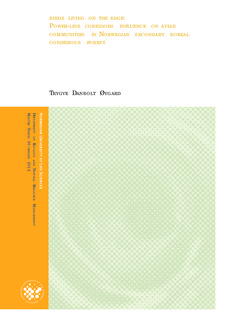| dc.contributor.author | Øygard, Trygve Danbolt | |
| dc.date.accessioned | 2012-11-16T10:05:03Z | |
| dc.date.available | 2012-11-16T10:05:03Z | |
| dc.date.copyright | 2012 | |
| dc.date.issued | 2012-11-16 | |
| dc.identifier.uri | http://hdl.handle.net/11250/186907 | |
| dc.description.abstract | Power-line corridor edges differ from other edge habitats by its long shape with a high
amount of edge habitat compared to open fields, and the regular maintenance clearing the
corridor for forest trees not allowing forest re-growth. Power-line corridors in northern boreal
secondary coniferous forests have a low avian abundance compared to the adjacent edge
habitat. Bird species associated with open fields and clearings do to a very little extend appear
in the power-line corridor. The edge habitat does have the highest avian abundance and
richness compared to both the corridor habitat and the adjacent forest interior. Species
abundance is highly influenced by the forest development classes, where most birds are found
in the middle classes where forest net primary production is highest. | no_NO |
| dc.description.sponsorship | Norwegian Water Resources and Energy Directorate (NVE) and The Norwegian Directorate
for Nature Management | no_NO |
| dc.language.iso | eng | no_NO |
| dc.publisher | Norwegian University of Life Sciences, Ås | |
| dc.subject | Edge effects | no_NO |
| dc.subject | Avian abundance distribution | no_NO |
| dc.subject | Birds in boreal forest | no_NO |
| dc.subject | Ecology | no_NO |
| dc.subject | Natural resource management | no_NO |
| dc.subject | Natural Science | no_NO |
| dc.subject | Biodiversity | no_NO |
| dc.title | Birds living on the edge : power-line corridors influence on avian communitites in Norwegian secondary coniferous forest | no_NO |
| dc.type | Master thesis | no_NO |
| dc.subject.nsi | VDP::Agriculture and fishery disciplines: 900::Agriculture disciplines: 910::Management of natural resources: 914 | no_NO |
| dc.subject.nsi | VDP::Mathematics and natural science: 400::Zoology and botany: 480::Ecology: 488 | no_NO |
| dc.source.pagenumber | 27 | no_NO |
